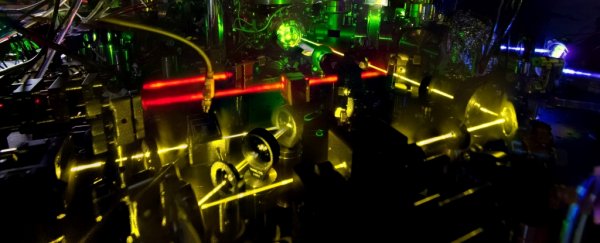Atomic clocks, based on the minute oscillations of atoms, are the most precise timekeeping devices humans have created.
Every year, scientists make adjustments that improve the precision of these devices. Now, they've achieved new performance records, making two atomic clocks so precise they could detect gravitational waves, those faint ripples in the fabric of space-time.
The dauntingly clever physicists at the US National Institute of Standards and Technology (NIST) achieved these records in three of the most important measures used to judge atomic clock performance: systematic uncertainty, stability and reproducibility.
"[It] can be considered the 'royal flush' of performance for these clocks," explained NIST physicist Andrew Ludlow.
Both of the new record-breaking clocks are based on ytterbium atoms. In each clock, an optical lattice made of lasers holds a thousand of these atoms immobile. These lasers excite the electrons of the atoms, which then oscillate, switching with incredible regularity between two energy states.
Like the ticking of an analog clock, this energy switching can be used to keep time - but with much greater precision than any analog, or even digital clock. The most recent record-breaker, released last year, was so precise it would could keep time without losing or gaining a second for 15 billion years.
And the standard second is defined by the oscillations of a caesium atom. So, you know, pretty amazingly precise stuff.
So what do these new records mean?
Systematic uncertainty refers to whether the clock is accurately keeping time with the oscillations of the atoms. The two clocks were in sync with the frequency of the ytterbium with an error rate of 1.4 parts in 1018.
Stability refers to the change in the clock's frequency over a specific time period. The ytterbium clocks' change was just 3.2 parts in 1019 (or 0.00000000000000000032).
And finally, reproducibility refers to how closely the clocks tick at the same frequency. Their difference was below the level of 10-18, or a billionth of a billion. And this is the money shot.
"The agreement of the two clocks at this unprecedented level, which we call reproducibility, is perhaps the single most important result, because it essentially requires and substantiates the other two results," Ludlow said.
"This is especially true because the demonstrated reproducibility shows that the clocks' total error drops below our general ability to account for gravity's effect on time here on Earth.
"Hence, as we envision clocks like these being used around the country or world, their relative performance would be, for the first time, limited by Earth's gravitational effects."
This mind-blowing precision is sure to benefit many of the instruments and experiments where atomic clocks are used.
One example are global positioning systems, which receive signals from satellites equipped with atomic clocks, then measure the time delay of the signal from each satellite and convert them into spatial coordinates.
Atomic clocks have also been used to detect and measure time dilation, the effect of velocity or gravity on time. Relative velocity slows time. Greater gravity also slows time; for example, at higher altitudes on Earth time actually moves a wee bit faster.
Because of this difference, atomic clocks can be placed at different altitudes to measure gravity itself. This means these new clocks could - theoretically - be used to measure the shape of Earth's gravitational field, a field known as relativistic geodesy, to within an accuracy of a centimetre.
But atomic clocks this precise, and so sensitive to gravity, could also potentially detect the incredibly faint signals from gravitational waves.
And there's the incredibly tantalising prospect of dark matter, which we've never yet detected directly. Theoretically, when atomic clocks interact with dark matter, they can speed up or slow down - but by absolutely miniscule fractions of a second. Synchronised atomic clocks can make these discrepancies detectable in a way that other clocks cannot.
These applications have yet to be applied with these new record breakers - with the amount of laser power required, they're kind of lab-bound right now. But it's certainly an exciting leap forward.
The team's research has been published in the journal Nature.
